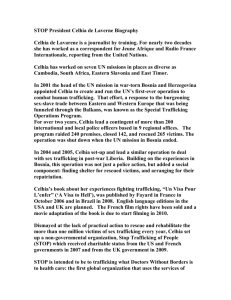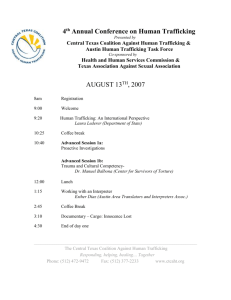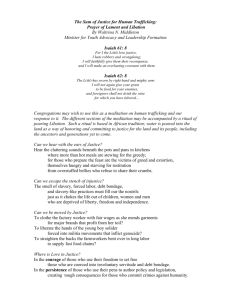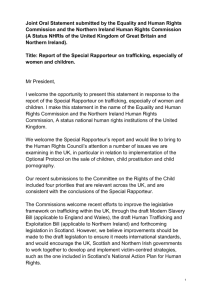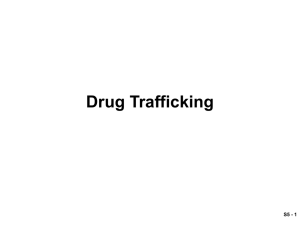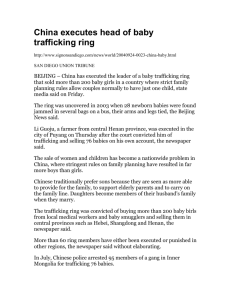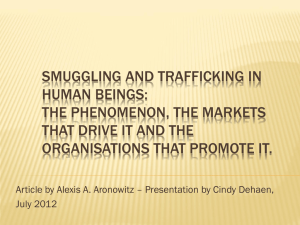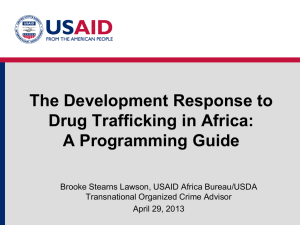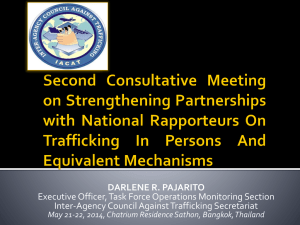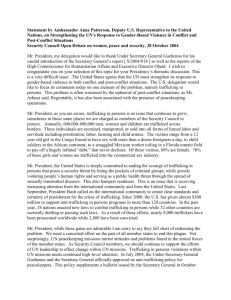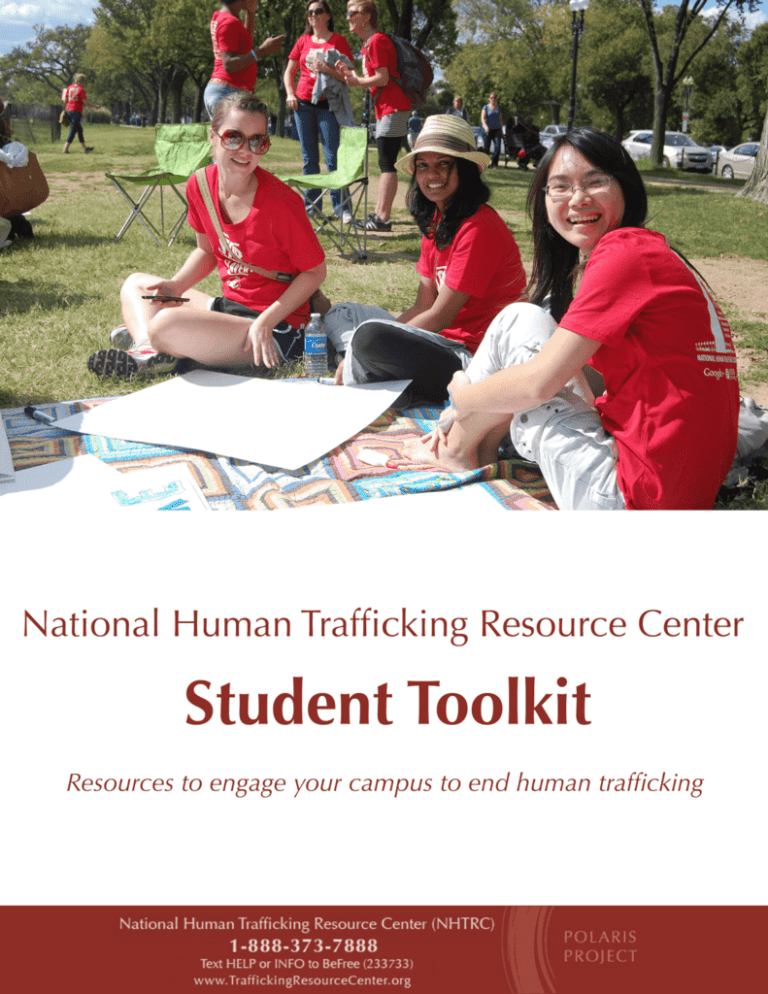
NATIONAL HUMAN TRAFFICKING RESOURCE CENTER (NHTRC)
STUDENT TOOLKIT
Purpose of the Toolkit
The National Human Trafficking Resource Center (NHTRC) Student Toolkit is designed to provide
students with resources to identify and raise awareness of human trafficking in their community. As a
student, you can play an active role in educating others about human trafficking, promoting the NHTRC
hotline, and preparing your campus community to take a stand against human trafficking. We encourage you
to tailor your awareness activities to your specific university and community, using these resources as a
starting point.
About the NHTRC
The NHTRC is a 24-hour national, confidential, multi-modal hotline and resource center serving the United
States and U.S. territories. Our mission is to provide human trafficking survivors with access to critical
support and social services to get help and stay safe, and to equip the anti-trafficking field with the tools to
effectively combat all forms of human trafficking. Experienced hotline specialists provide around-the-clock
crisis support and connect human trafficking victims to safety, shelter, and other life-saving resources. The
hotline also receives tips of suspected human trafficking cases and provides information, training, and
technical assistance to diverse audiences across the U.S. and around the world. The NHTRC has been
operated since December 7th, 2007 by Polaris Project, a leading non-governmental organization in the global
fight against human trafficking and modern-day slavery, and is funded by the U.S. Department of Health
and Human Services as well as other supporters.
We strive to help communities build an effective local response to human trafficking and increase the
number of victims identified and connected with services. With your help, we can achieve this goal. Since
December 2007, we have taken more than 87,000 calls. Every day the NHTRC receives tips from
community members who come across victims of labor and sex trafficking in the course of their day-to-day
routines. In 2012 alone, the NHTRC received information about 3,445 potential cases of sex and labor
trafficking.
However, there are people across the U.S. who still do not know about the NHTRC hotline, or that human
trafficking takes place within our borders. We are asking for your help in spreading awareness so that we can
reach more victims of human trafficking.
National Human Trafficking Resource Center (NHTRC)
• Call 24/7: 1-888-373-7888
• Call 911 in an emergency
• Text: BeFree (233733)
• Email: nhtrc@polarisproject.org
• Report a Tip Online or Access Resources and Referrals: www.traffickingresourcecenter.org
This publication was made possible in part through Grant Number 90ZV0087 from the Anti-Trafficking in Persons Division, Office of Refugee Resettlement,
U.S. Department of Health and Human Services (HHS). Its contents are solely the responsibility of the authors and do not necessarily represent the official
views of the Anti-Trafficking in Persons Division, Office of Refugee Resettlement, or HHS.
Polaris Project | National Human Trafficking Resource Center | 1-888-373-7888 | NHTRC@PolarisProject.org
www.TraffickingResourceCenter.org © Copyright Polaris Project, 2013. All Rights Reserved.
-i-
TABLE OF CONTENTS
Introduction: Your Role as a Student ........................................................................................................................... 1
What is Human Trafficking? .......................................................................................................................................... 2
Common Myths & Misconceptions .............................................................................................................................. 3
10 Ways to Raise Awareness of Human Trafficking and the Hotline ..................................................................... 4
Starting an Anti-Trafficking Organization on Your Campus.................................................................................... 5
Tips for Promoting the NHTRC Hotline Number .................................................................................................... 7
Promoting Awareness of Human Trafficking Using Social Media .......................................................................... 9
Places to Post the Hotline Flyer and Other Anti-Trafficking Posters ...................................................................10
General Audience Email Template .............................................................................................................................11
National Human Trafficking Resource Center Flyer..................................................................................................12
- ii -
INTRODUCTION: YOUR ROLE AS A STUDENT
The National Human Trafficking Resource Center (NHTRC) relies on individuals like you with unique
experiences, skills, and connections within your community to get the word out and help prepare your
community to respond to human trafficking. Cases of human trafficking have been reported in all 50 states
and in a variety of environments, including: legal and illegal settings, cities, suburbs, and rural areas, and high
and low-income areas. Often, community members come across labor and sex trafficking situations in their
day-to-day routines.
Without an understanding of human trafficking indicators, many community members will miss the
opportunity to identify a potential human trafficking situation or help someone in need. Others may
recognize the signs, but do not know how to reach out for help. Raising awareness about how to identify
and report human trafficking is essential. Many victims do not self-identify or are not aware that help is
available.
Engage: As students, you are in a position to engage and raise awareness with key local stakeholders,
including:
Campus police
Campus counseling
Educators and education professionals
Local businesses, shops, restaurants
Campus library staff
Campus clubs and student
organizations
Faith-based organizations and groups
Neighbors, friends, and family
Hospital and health professionals
Educate: It is important to educate yourself and your community on the different types of human
trafficking that can occur. Visit www.traffickingresourcecenter.org to access interactive trainings and
webinars on a variety of topics related to human trafficking. Our website also features an interactive map
and state reports that provide useful state data and human trafficking trends reported to the NHTRC.
Create: You know your community best and we encourage you to be creative. Students have created
television and radio PSAs, developed websites, held walks to raise awareness, written and performed plays,
hosted fashion shows, approached businesses to post the hotline flyer, conducted trainings for community
groups, and encouraged their campus to commit to using goods and services produced without slavery.
Take Action: Now it's time for you to get started. Good luck and thank you for working with us to help
end human trafficking in the United States. Please email us at NHTRC@polarisproject.org to share your
successes and ask any questions!
With help from students we can:
Identify more survivors of human trafficking and help them access shelter, counseling, legal
assistance, and other critical social services across the country.
Alert law enforcement agents to cases of human trafficking so they can stop traffickers from
exploiting women, men, and children across the United States.
Prevent exploitation of vulnerable populations through education and awareness of the risk factors
and red flags to look out for.
-1-
WHAT IS HUMAN TRAFFICKING?
Human trafficking is a form of modern-day slavery where people profit from the control and exploitation of
others. Although slavery is commonly thought to be a thing of the past, human trafficking still exists today
throughout the United States and globally. Human trafficking is the use of force, fraud, or coercion to
control a person for the purpose of engaging in commercial sex acts or labor services against his/her will.
Traffickers use violence, threats, blackmail, false promises, deception, manipulation, and debt bondage to
trap vulnerable individuals in situations of commercial sex or labor for profit. Sex trafficking has been
found in a wide variety of venues within the sex industry, including residential brothels, online escort
services, fake massage businesses, strip clubs, and street prostitution. Labor trafficking has been found in
diverse labor settings including domestic work, small businesses, large farms, and factories.
All trafficking victims share one essential experience – the loss of freedom.
Why Trafficking Exists
There are two primary factors driving the spread of
human trafficking: high profits and low risk. Like
drug and arms trafficking, human trafficking is a
market-driven criminal industry that is based on
the principles of supply and demand. Every year,
human traffickers generate billions of dollars in
profits by victimizing millions of people around
the world, including here in the U.S.
The Traffickers
Traffickers lure and ensnare people into forced
labor and sex trafficking by manipulating and
exploiting their vulnerabilities. Human traffickers
prey on people who are hoping for a better life,
lack employment opportunities, have an unstable
home life, or have a history of sexual or physical
abuse. Runaway and homeless youth are
particularly at risk. Traffickers promise a highpaying job, a loving relationship, or new and
exciting opportunities. In other cases, they kidnap
victims or use physical and psychological violence
to control them. Traffickers can be lone individuals
or part of extensive criminal networks, with the
common thread of exploiting people for profit.
The Victims
The International Labor Organization estimates
that there are 20.9 million victims of human
trafficking globally, with hundreds of thousands in
the U.S. The victims of this crime in the U.S. are
men and women, adults and children, and foreign
nationals and U.S. citizens. Victims have diverse
socio-economic backgrounds, varied levels of
education, and may be documented or
undocumented, but what is common is their
vulnerability. As defined under U.S. law, victims of
human trafficking can be divided into three
populations:
Children under age 18 induced into
commercial sex.
Adults age 18 or over induced into commercial
sex through force, fraud, or coercion.
Children and adults induced to perform labor
or services through force, fraud, or coercion.
Indicators of Human Trafficking
Not free to come and go as he/she wishes
Under 18 and providing commercial sex acts
Unpaid, paid very little, or paid only with tips
Works excessively long hours, no breaks
Has few or no personal possessions
Is not in control of his/her own money
Owes a large debt and is unable to pay it off
Recruited through false promises
High security measures at work or residence
Signs of physical/sexual/emotional abuse
For a full list of indicators, visit:
polarisproject.org/indicators
-2-1-
-
COMMON MYTHS & MISCONCEPTIONS
Human Trafficking must involve some form of travel, transportation, or movement
across state or national borders.
Reality: The federal definition of human trafficking does not require transportation, although
transportation may be involved in the crime. Human trafficking is not synonymous with forced
migration or smuggling. Instead, human trafficking is more accurately characterized as “compelled
service” where an individual’s will is overborne through force, fraud, or coercion.
Trafficked persons can only be foreign nationals or immigrants from other
countries.
Reality: The federal definition of human trafficking includes both U.S. citizens and foreign nationals both have been equally protected under federal trafficking statutes since the Trafficking Victims
Protection Act (TVPA) of 2000. Human trafficking encompasses both transnational trafficking that
crosses borders and domestic or internal trafficking that occurs within a country. Statistics on the scope
of trafficking in the U.S. are only comprehensive if they include U.S. citizens as well as foreign nationals.
All victims of sex trafficking are females minors.
Reality: Anyone can be a victim of sex or labor human trafficking, regardless of age, gender, ability,
sexual orientation, or socio-economic status. Traffickers choose their victims based on vulnerability,
which can be easily exploited. However, all people under 18 (girls and boys) who are induced to commit
commercial sex acts are victims of human trafficking. For adult men and women, the commercial sex act
is considered human trafficking if it is compelled by force, fraud, or coercion.
If a person consented to their initial situation, was informed about what type of
labor they would be doing, or knew that commercial sex would be involved, then
it’s not trafficking.
Reality: A person cannot consent to being a victim of human trafficking. One’s initial consent to provide
labor and/or commercial sex is no longer relevant once force, fraud, or coercion is used to compel that
person to continue to provide labor or commercial sex against his/her will. Under federal law, a person
under age 18 cannot meaningfully consent to commercial sex; therefore, all minors induced into
commercial sex are considered victims of human trafficking.
There must be elements of physical restraint, physical force, or physical bondage when
identifying a trafficking situation.
Reality: The legal definition of trafficking does not require physical restraint, bodily harm, or physical
force. Psychological means of control, such as threats, or abuse of the legal process, are sufficient
elements of the crime.
Victims of human trafficking will immediately ask for help or assistance and will self-identify as
a victim of a crime.
Reality: Victims of trafficking often do not immediately seek help or self-identify as victims of a crime
due to lack of trust, self-blame, or training by the traffickers. This is why it is critical that law
enforcement, social service providers, and community members learn to recognize the signs.
-3-
-3-
10 WAYS TO RAISE AWARENESS OF
HUMAN TRAFFICKING AND THE HOTLINE
1.
PROGRAM the National Human Trafficking Resource Center (NHTRC) hotline
number in your phone: 1-888-373-7888 or text BeFree (233733)
2.
DISTRIBUTE POSTERS with the hotline number around campus. Use the flyer
included in this pack, or download it here and post copies around your campus where
students are likely to see it.
3.
START an anti-trafficking group at your school. If your campus already has an antitrafficking group, get involved. Partner with other organizations and brainstorm more
ways to raise awareness of human trafficking and promote the hotline. (See pages 5-6)
4.
HOST a film screening and discussion. For a list of recommended documentaries,
movies, and other films, visit this site.
5.
VISIT the NHTRC website for interactive trainings and webinars on a variety of
topics related to human trafficking by clicking here.
6.
WRITE an article for your school’s newspaper or a local blog. Write a letter to the
editor or an editorial for the opinion section, or share information on social
networking sites (see page 9). Discuss human trafficking and how it affects your
community, and then encourage people to call the hotline to report tips.
7.
ADVOCATE for state and federal policy related to the crime of human trafficking.
Track pending legislation in your state. Some bills require mandatory posting of the
hotline number. Attend human trafficking lobby days and contact your representatives
to urge them to support these bills.
8.
TALK about human trafficking. Many colleges host themed parties that glorify pimps
and pimp culture. Use this opportunity to start a dialogue about the realities of human
trafficking. You can also look into your university’s supply chain and talk to your
university administration about how they can take steps to ensure their supply chain is
free of human trafficking.
9.
FOCUS a project on human trafficking. Write an essay, research paper, or create a
poster for one of your class projects on human trafficking and the NHTRC. You may
earn course credit while raising awareness!
10.
CREATE a listserv at your college or university for students and faculty interested in
human trafficking.
-4-
STARTING AN ANTI-TRAFFICKING ORGANIZATION ON YOUR CAMPUS
Registration and Approval:
Most schools have specific guidelines for the creation of a new campus organization. You must first review
these guidelines to determine the application and registration procedure. Information can usually be found
on your school’s student activities webpage. In order to apply for appropriations, reserve spaces, and use
available resources, your organization must be registered with the university. Registration may involve filling
out an application, finding a faculty advisor, attendance at informational meetings and workshops, and/or
signing a contract or agreement with the university.
Writing a Constitution:
Some schools require organizations to have a constitution in order to register. Often colleges and
universities will supply a constitution template, but templates can also be found online (especially if you are
starting a campus chapter under a parent organization). While writing a formal constitution can take time, it
is necessary to think about and discuss the purpose of your organization and how it will operate. A
constitution should include the following components:
Mission Statement: Your mission statement should concisely explain your organization’s purpose,
aims, and objectives. Define over-arching goals, as well as the strategies you will use to achieve them.
Officers: Your constitution should have a section describing organizational leadership. Some schools
require that every student organization have at minimum a president and a treasurer. For planning and
logistical purposes, it can be helpful to keep the executive team small, consisting of 5 to 7 students. It is
important to include language regarding how each officer will be elected or appointed, and the term he
or she will serve in that position. This section may also provide procedural guidelines in the event of an
officer conflict or impeachment. Some suggested officer positions include:
President – The president serves as the representative of the organization to the university and
community; this person is responsible for leading all general body and officer meetings, overseeing
the activities of the chapter, monitoring the use of funds, and communicating with the university
and the parent organization (if applicable).
Treasurer – The treasurer usually develops the budget, maintains the organization’s accounts,
develops strategies for fundraising, applies for university funding, and manages reimbursements.
Chair of Events – This officer can have a wide range of responsibilities, which can include engaging
members, students, and the community. They can do so by planning events, organizing and
managing all logistical aspects of club activities.
Chair of Publicity – This officer coordinates advertising and public relations efforts for organization
activities and member recruitment.
Chair of Education – This officer is knowledgeable regarding the issue of human trafficking and helps
members and the community understand what human trafficking is and what can be done to fight it.
Secretary – The secretary maintains meeting agendas, minutes, and attendance records. He or she can
also oversee the organization’s email and mailing lists, write the newsletter, and manage other
administrative tasks as needed.
-5-
Membership: This section should always be in compliance with your school’s non-discrimination
clause, which can be found on the school website. This section should also include guidelines for
membership, including the payment of annual dues and requirements for participation and attendance.
Meetings: This section can include language regarding how often the organization will meet, who will
lead meetings, and guidelines for participation by the general body.
Finance: The finance section defines the organizational procedure for the expenditure of funds,
reimbursements, and collecting donations.
Amendments and By-laws: This section mandates an established procedure for amending the
constitution and the voting process that must take place in order to pass a new by-law.
Advertising:
Be sure to spend a significant amount of time spreading the word about your new organization. As human
trafficking is an issue receiving increasing public attention, there are sure to be other students who are
interested in getting involved in the movement. To start, reserve a table at your school’s activities fair at the
beginning of the year, and continue to get the word out about meetings and events through flyering,
chalking, social media, and inviting everyone you know to meetings and events. Don’t be afraid to reach out
to faculty, administrators, and prominent community members and media venues to help spread the word.
More Student Resources:
Many other organizations have also developed tools for students to bring the anti-trafficking movement to
their campus. If you are looking for more ways to spread the word about human trafficking and equip your
group members, check out the following links:
Chicago Alliance Against Sexual Exploitation (CAASE)
The Free Project
Free the Slaves
International Justice Mission (IJM)
Love146
mtvU: Against Our Will
Not for Sale
UNICEF
References:
In developing these guidelines, we referenced the constitution of the International Justice Mission campus
chapter at the University of Virginia:
https://atuva.student.virginia.edu/organization/internationaljusticemission
-6-
TIPS FOR PROMOTING THE NHTRC HOTLINE NUMBER
Best Practices for Posting the NHTRC Hotline Flyer:
Ask before posting a hotline flyer!
Consider posting the hotline number in different languages. Think about the language
demographics of your community and choose awareness materials accordingly.
Look for prominent and eye-catching locations to post the hotline number. For example, if
posting a flier in a public restroom, tape it to the bathroom stall door.
Use pre-existing and well-known places where information is regularly posted.
Talk directly to friends, family and neighbors about the services provided by the NHTRC.
Recruit campus, community, and faith-based leaders to promote the NHTRC.
What You Should Know:
Human trafficking is a crime. Traffickers use force, fraud, or coercion to exploit people
through commercial sex or forced labor.
If someone you know is being trafficked he/she can get help, including access to counseling,
shelter, legal assistance, and more, by calling 1-888-373-7888 or texting BeFree (233733).
You can also report a tip about human trafficking to the hotline by calling 1-888-373-7888,
texting BeFree (233733), or submitting a report at www.traffickingresourcecenter.org.
The hotline is a national, confidential, toll-free hotline, available 24/7 in 170 languages.
All calls and texts are answered live by trained NHTRC Call Specialists. The NHTRC is not
a government entity, law enforcement, or an immigration authority.
Suggested Script: The following script can be used when approaching organizations and businesses in person.
Brief Introduction:
Hi, my name is [insert your name here] and I am a student at [insert your school here]. I am raising
awareness about human trafficking and the National Human Trafficking Resource Center or
NHTRC, a 24/7 hotline that serves victims of human trafficking in the community. Would you
mind if I posted a flyer about this organization here at [insert business here]? Educating the public
is the first step to stopping this crime and helping victims. Your support would be a big help.
Extended Introduction:
Human trafficking is modern-day slavery. It occurs when traffickers use deception,
manipulation, threats, or even violence to coerce a person into labor or commercial sex. Human
trafficking occurs all over the world, including the United States, in big cities and small towns.
Human trafficking victims include men, women, children, U.S. citizens and foreign nationals.
The NHTRC works to stop human trafficking by operating a 24-hour, toll-free, confidential
hotline. The hotline can connect victims with law enforcement and social service providers in
their area who can help them get out of exploitative situations and into safe environments where
they have access to services, such as emotional support, shelter, counseling, and legal services.
The hotline also provides referrals, resources, general information, and training and technical
assistance.
-7-
Audience:
It is important to consider not only who has influence in your community, but also who works
on issues related to human trafficking and might be interested in helping. The following
organizations and individuals may reach large audiences and/or have a stake in helping to
promote the hotline. They may also have opportunities for you to volunteer in your community.
Campus Community: Student organizations, Greek life, service learning clubs, internship and
career services, and student services all value the importance of service and philanthropy. These
are great resources to utilize to help promote the hotline.
Community Resources: Libraries, community centers, schools, and faith-based organizations
always appreciate material to provide to the community.
Service Providers: domestic violence and sexual assault centers, reproductive health centers,
homeless shelters, shelters for runaway and homeless youth, migrant worker clinics, and campus
health centers might serve survivors of trafficking and be interested in obtaining information.
Local Leaders: find an article about human trafficking in your home state and tweet it at your
mayor, your sheriff, or your state lawmaker. You can get their attention and let them know
there’s a hotline to call for more information on this issue.
Additional Educational & Promotional Resources:
The NHTRC Newsletter: The NHTRC newsletter is a tool to engage and inform community
members, service providers, government officials, and law enforcement about developments in
the anti-human trafficking movement. Each month we share a variety of guides, such as
assessment tools, in-depth reviews of specific trafficking networks, or resources for assisting
specific populations or building response protocols. We also share information about events,
trainings, hotline statistics, and hotline vignettes.
Outreach Materials: Click here to download hotline flyers in 20 different languages and click
here to order hotline stickers and magnets. Polaris Project has also made various outreach and
awareness materials available for purchase on Cafepress.com. The Department of Health and
Human Services (HHS) has developed a variety of outreach and awareness raising materials for
service providers and community members as part of their Rescue and Restore Campaign. Click
here to access Rescue & Restore posters and brochures.
General Information Resources: To access general information on human trafficking and
download free educational tools and materials, visit our resource topics page.
Volunteer Opportunities: To learn about opportunities to volunteer with local organizations
working on the issue of human trafficking, visit our state map and click on your state.
-8-
PROMOTE AWARENESS OF HUMAN TRAFFICKING
USING SOCIAL MEDIA
FACEBOOK:
With over 1 billion users, Facebook is a powerful tool to raise awareness about human trafficking
and the National Human Trafficking Resource Center (NHTRC).
Dedicate your Facebook profile to human trafficking and the NHTRC for one week by
changing your profile picture and cover photo to an image that includes the NHTRC hotline or
texting number.
Make frequent status updates that educate others about the issue of human trafficking and the
services offered by the NHTRC.
Post links to the NHTRC through www.traffickingresourcecenter.org.
TWITTER:
Twitter has demonstrated the power of 140 characters to share big ideas through short messages.
Tweet about human trafficking and the NHTRC using the hashtags #call8883737888 or
#txtBeFree, and human trafficking using #humantrafficking, #sextrafficking, #labortrafficking
or #slavery.
Re-tweet messages from anti-trafficking organizations.
Change your profile picture or Twitter background to an image that includes the NHTRC
hotline or text number.
INSTAGRAM:
Instagram allows us to share our lives through images. Over 100 million people access this form of
social media regularly, making it a simple yet powerful tool to share your message.
Instagram photos of the NHTRC logo or hotline number.
Hashtag relevant anti-trafficking movements and organizations.
PERSONAL BLOGS AND TUMBLR:
Write about the issue of human trafficking and the NHTRC on your personal blog.
Retumble information from anti-trafficking organizations or supporting campaigns.
Make a gifset about indicators of human trafficking and how to report tips to the NHTRC.
Post the NHTRC widget on your blog.
YOUTUBE AND VINE:
Record a video or Vine about why you want to end human trafficking in your lifetime.
Make a video or a Vine about human trafficking in your state, using animation or a speech. Read
our state reports to discover what kinds of trafficking calls come from your area.
-9-
PLACES TO POST THE NHTRC HOTLINE FLYER AND
OTHER ANTI-TRAFFICKING POSTERS
Civic and Education
Community
Courthouses
Police Stations
Campus Libraries
Local High Schools
ESL Classrooms and Centers
Places of Worship (Churches, Mosques,
Synagogues, Temples, etc.)
Farmers Markets
Parks
Community Events
Community Centers
University Bulletin Boards
Stadiums
Concert Halls
Apartment Bulletin Boards
Public Restrooms
Businesses
Malls
Movie Theaters
Grocery Stores
Gas Stations
Gyms
Coffee Houses
Restaurants/Dining Halls
Convenience Stores
Hair and Nail Salons
Bars and Liquor Stores
Hotels/Motels
Construction Sites
Social Services
Shelters
Soup Kitchens
Domestic Violence/
Sexual Assault Centers
Transit
Bus Stops
Greyhound Stations
Metro/Subway
Truck Stops
Busy Street Intersections
Health
University Hospitals
University Health Clinics
Doctors’ Offices
Migrant Health Clinics
Reproductive Health Centers
-10-
GENERAL AUDIENCE EMAIL TEMPLATE
The following text is a general audience email template. You can send this message to individuals,
organizations, and agencies in your community who might be interested in learning about human trafficking
and the National Human Trafficking Resource Center (NHTRC). We encourage you to personalize the
message by explaining how this issue and these resources may be relevant to this person and his/her work.
Feel free to customize any of the following language, but always remember to introduce yourself and the
organization and school you represent.
Hello:
We are writing to you on behalf of [insert your organization’s name here] at [insert the name of your school] in order to
raise awareness of the National Human Trafficking Resource Center (NHTRC). The NHTRC is a 24-hour
national, confidential, multi-modal hotline and resource center whose mission is to provide human
trafficking survivors with access to critical support and social services to get help and stay safe, and to equip
communities with the tools to effectively combat all forms of human trafficking.
Human trafficking is a form of modern-day slavery where people profit from the control and exploitation of
others. Although slavery is commonly thought to be a thing of the past, human trafficking still exists today
throughout the United States and globally when a trafficker uses force, fraud, or coercion to control another
person for the purpose of engaging in commercial sex acts or labor services against their will.
Human trafficking is a crime that affects all countries, all cities, and all classes of society. The NHTRC has
received reports of human trafficking from every state in the country and helped thousands of victims
receive services and support. The NHTRC now receives thousands of calls every month. Around the world,
the International Labor Organization estimates 20.9 million people are victims of either labor or sex
trafficking.
[Insert a few sentences about why human trafficking and the NHTRC may be relevant to this particular recipient as well as a
specific action you want the recipient to take. For example:
1. For a domestic violence clinic or other service provider: Please consider referring clients who exhibit indicators of human
trafficking to the NHTRC to access specialized services. All calls are confidential.
2. For a Spanish-language radio station: Please consider sharing the NHTRC hotline number with your audience. They
have 24/7 Spanish-language support and radio is a vital way to reach this population.
3. For a local business: Please consider posting the hotline number in your business to help raise awareness of this crime
and connect victims to help.
4. For local law enforcement: Please consider reaching out to the NHTRC for training on recognizing the signs of human
trafficking.
If you are interested in learning more about the NHTRC and human trafficking, please visit the NHTRC
website: www.traffickingresourcecenter.org and sign up for our newsletter at
www.polarisproject.org/signup.
Thank you for your interest in learning how to stop human trafficking in our community.
-11-

